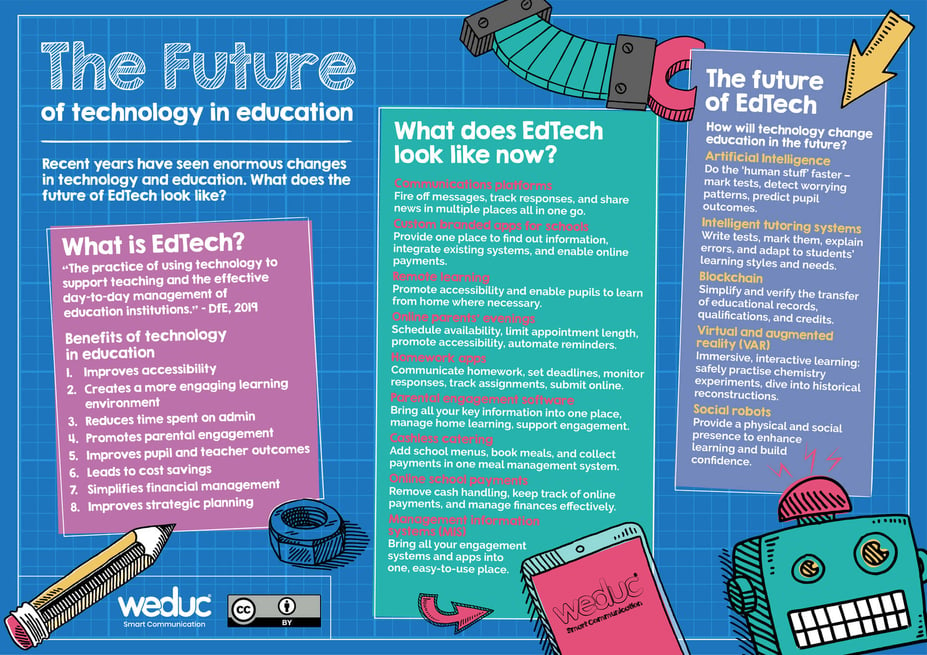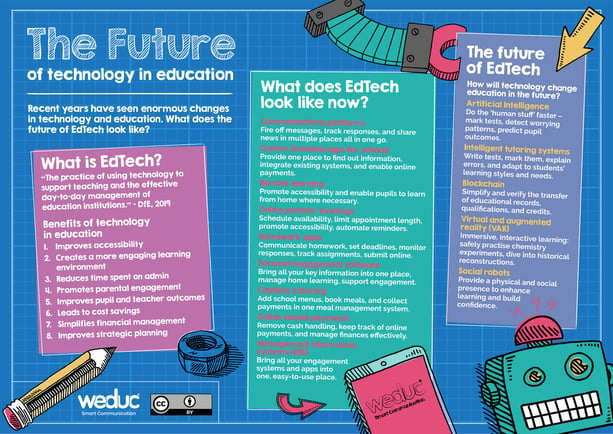According to research by The DfE, the EdTech sector is set to be worth £331bn globally by 2025 – yet, education has also been described as “grossly under digitised”, with less than 4% of worldwide education budgets being spent on tech.
These stats paint an enlightening picture of the future of technology in education. It’s a growing area, but not necessarily one that all schools and multi-academy trusts are making the most of. But with benefits including time savings, reduced workload, enhanced learning experiences, and improved parental engagement, future-thinking schools and MATs are putting EdTech at the top of their agenda for 2023.
What are the benefits of technology in education?
- Improves inclusivity
One of the major future technology trends in education surrounds inclusively. For students, EdTech brings more flexibility to those with diverse requirements, offering options like virtual lessons and built-in SEND notes on students’ digital profiles. And for parents, EdTech provides the opportunity to reach parents across multiple channels, not only improving communications but also accommodating those who can’t travel by opening up the possibility of virtual meetings as well as face-to-face events.
- Creates a more engaging learning environment
EdTech opens the door for teachers to create engaging lessons that suit a range of learning styles, incorporating things like interactivity, videos, and digital assessments into the everyday.
- Reduces time spent on admin
Future education technology is set to find more and more ways to automate processes and save staff time. Tech integration reduces the need to duplicate entries across systems while helping to cut out any possible errors; payment systems reduce time spent counting and banking payments; and when it comes to one of the most complex events in the calendar – parents evening – there are specialised systems available to reduce the workload and make the event run smoothly.
- Promotes parental engagement
And speaking of parents, EdTech opens up new lines of communication between parents and carers, with digital parents’ evenings, digital homework formats, and simple online forms.
- Improves pupil and teacher outcomes
EdTech gives teachers the freedom to get creative with their teaching and find new ways to engage every child in their classroom – which adds up to a better educational experience for all.
- Leads to cost savings
Opting to go digital with communications and classroom resources will reduce your admin workload and your printing costs. Plus, giving your staff the time back to focus on their teaching will lessen your labour costs, too.
- Simplifies financial management
EdTech includes options like cashless payment systems, which not only lowers security risks but simplify finances for both your school and your parents.
Check out our ‘Future of Technology in Education’ infographic for answers to questions like:
‘What is EdTech?’, and ‘How will technology change education in the future?’

What does technology look like in education – and what problems does it solve?
When thinking about the future of EdTech, or about introducing any new EdTech into your school or MAT, you want to know about the exact everyday problems it’ll solve. Here are a few of those common issues, and the technology that’s making them more manageable.
If you’ve encountered security risks due to holding cash on-site or had parents ask whether they can pay for school meals and trips digitally, a payment platform allows you to process all payments in one place – making things easier for you and your parents.
If you’ve found difficulties trying to engage parents – and keep them engaged – an all-in-one parent app is ideal for busy parents. This kind of EdTech replaces disjointed, paper-based communication to put all the key school information in one place.
Maybe you’re one of the schools that finds it difficult to manage mealtimes? You’re not alone. From navigating menu choices to allergy information, there’s a lot to consider when it comes to meal management. But there are technological solutions available to help you manage the menu and finances associated with mealtimes – making things simpler for everyone.
Had parents been unable to make parents’ evening due to accessibility issues or other commitments? A major advancement in EdTech is that many parents’ evenings are now managed digitally. These systems allow teachers to schedule their own availability, give parents the freedom to choose an appointment time that suits them, and improve attendance overall at these key events.
If you’re facing problems with disorganised students when it comes to their homework, a homework app is a piece of tech that not only encourages better organisation from students but makes visibility easier for teachers and parents, too.
Or perhaps you’ve already introduced some EdTech into your school, but you’re finding that a lot of the technology is working independently, rather than as one. There are all-in-one solutions available that combine communication, learning, payments, and admin in a single system, helping you fully embrace the future of EdTech.
The future of EdTech
So, we know what EdTech looks like now, and we can see how it’s making everyday school tasks simpler for teachers, parents, and students. But where do we go from here? When mapping the future of education technology, a few key trends emerge.
Security and safeguarding
Much of the emerging tech seems to relate to security and safeguarding. AI and machine learning will unlock the ability to do important tasks more quickly – and could be the key to spotting worrying patterns in a student’s attendance records. Blockchain is another piece of technology that’s improving safety, allowing educational records, qualifications, and currencies to be simplified and verified in a cost-effective way.
A new school reality
Virtual and augmented reality (VAR) is already becoming more accessible to schools, allowing students to enjoy interactive and immersive experiences that can enhance their learning of a subject, often in scenarios that wouldn’t otherwise be possible.
Intelligent tutoring
ITS software is creating a whole new level of personalisation when it comes to learning. These systems can write personalised questions, spot patterns in written and spoken work, adapt to individual or diverse learning styles, and present students with targeted learning materials. Also in this realm is the introduction of some robots and digital avatars into schools around the world – designed to enhance learning and build confidence. Although it is worth noting that both of these examples are more learning enhancers, and are by no means a substitute for the work of a highly trained and skilled teaching professional.
Want to know more about the future of EdTech?
If we’ve got your mind racing about the future of EdTech, we’ve created an in-depth guide to the latest trends and government research, including tips on formulating a tech strategy that ensures the very best student outcomes. Just click here to download it today.




